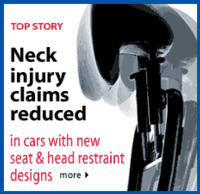 |
IIHS Head Restraint Study Shows "There Is A Difference"
|
October 22, 2002 NEW VEHICLE
SEAT & HEAD RESTRAINT DESIGNS ARE
|
|||||||||||||||||||||||||||||
|
|||||||||||
The key to reducing whiplash injury risk in rear-end crashes is to keep an occupant's head and torso moving together. The redesigned seats and head restraints are all intended to reduce the differential motion of the head and torso. The question addressed in the Institute's new research is whether these redesigned seats and head restraints are doing a better job of reducing neck injuries in rear-end crashes, compared with the designs in older models of the same cars.
"There's evidence that many of the new designs are working. In some cases, the reductions in insurance claims for neck injuries are dramatic," says Institute chief operating officer Adrian Lund, who is an author of the research report.
The researchers identified 2,641 property damage liability claims for rear-end crashes of the cars included in the study -- Taurus and Sable models with and without improved head restraint geometry, Volvo S70s with and without WHIPS, Toyota and Lexus models with and without the WIL system, plus a number of Buick, Nissan, Pontiac, and Saab models with and without active head restraints. The rates of insurance claims for driver neck injuries in rear-end crashes were compared before and after the seat and/or head restraint design changes. One definitive finding is a 43 percent reduction in neck injury claim rates for the Saab, General Motors, and Nissan models with active head restraints, compared with similar cars before such restraints were introduced.
"This is a huge improvement," Lund points out. Before/after comparisons of Volvos and Fords also yielded impressive reductions in claim rates, but these results weren't definitive because they weren't statistically significant. Still, "the results are encouraging, especially when we look at the even larger effects for women," Lund says.
In Toyotas with the WIL system, neck injury claim rates didn't decrease. In fact, there was a slight increase, but there were too few Toyota data for this result to be statistically significant. "These results are disappointing," Lund says, "but we're working with Toyota to get a better understanding of the results and to see if better results might be expected with newer WIL designs."
|
||||||||||||||||
Where reductions in neck injury claims were found, they were greater for women than for men. Saab's active head restraint design produced a 55 percent reduction in claim rates for women, compared with a 31 percent reduction for men. The effects of Ford's improved head restraint geometry were a 37 percent claims reduction for women and an 8 percent increase (nonsignificant) for men. Volvo's WHIPS was associated with a nonsignificant 69 percent reduction in neck injury claim rates for women, while the change for men was negligible.
Women's neck injury rates were much higher to begin with. "Throughout whiplash injury research, the finding has been that women are at greater risk, so it's good that the women seem to be enjoying more of the benefits of the improved designs," Lund says.
For more information on the IIHS study, see www.highwaysafety.org.


